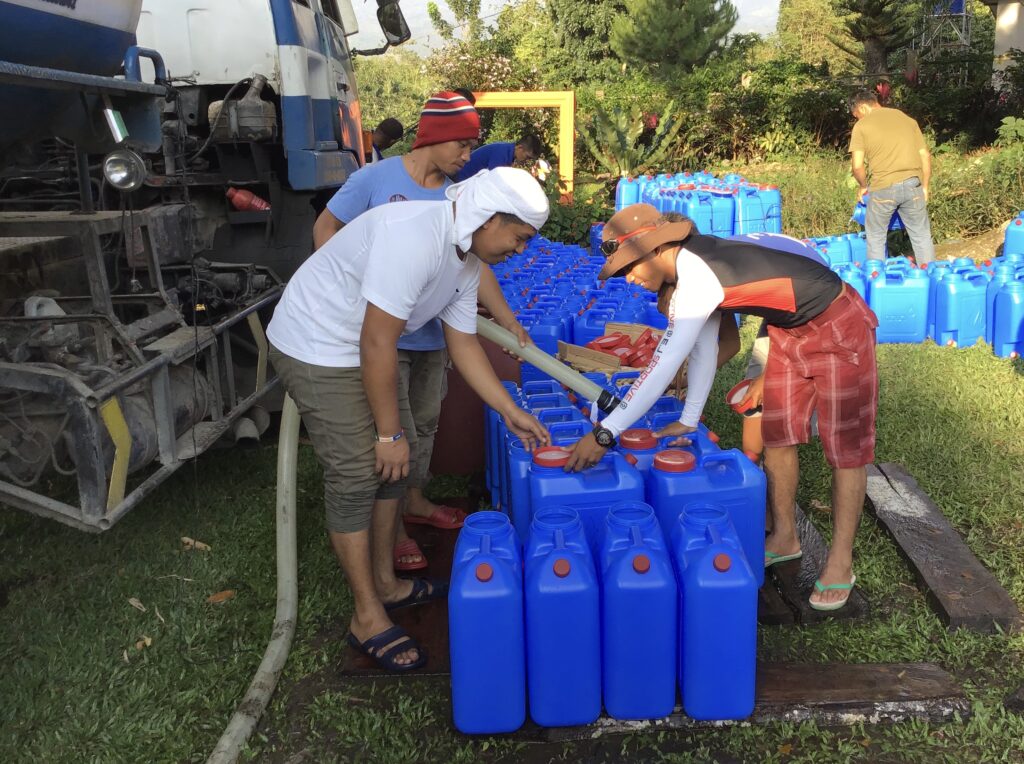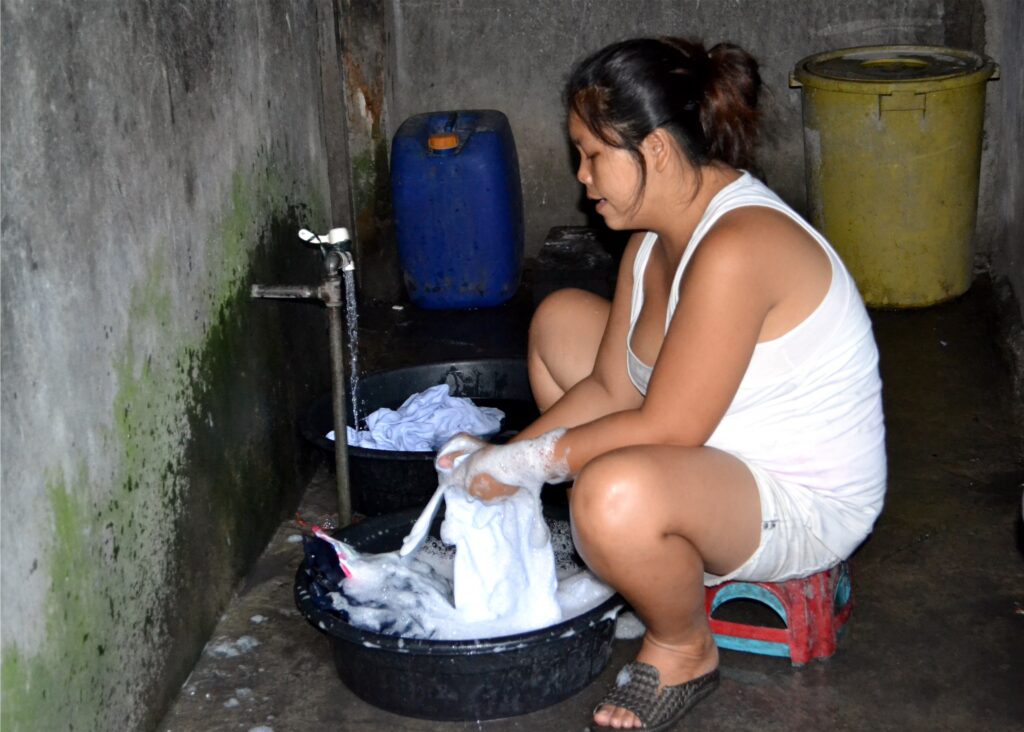Text and Photos by Henrylito D. Tacio
Not everyone experiences water shortage, but sooner or later, everyone will. There may not be enough water for all the people.
“Water tables are falling from over-pumping of groundwater… Many streams and rivers now run dry for portions of the year. Large inland lakes have shrunk to shadows of their former dimensions. Worldwide, freshwater wetlands – ecosystems that do a remarkable job of purifying water – have diminished in area by about half.”
That was what Sandra Postel and Amy Vickers wrote in a chapter for the annual report of Worldwatch Institute.
“Unlike copper, oil, and most other commodities, fresh water is not just a resource that acquires value only when it is extracted and put to human use. Most fundamentally, fresh water is a life support,” pointed out Postel, director of the Massachusetts-based Global Water Policy Project, and Vickers, author of “Handbook of Water Use and Conservation: Homes, Landscapes, Businesses, Industries, Farms.”
Water is indeed the world’s most important resource. “We’re surrounded by a hidden world of water,” pointed out Stephen Leahy, a Canadian journalist, and author. “Liters and liters of it are consumed by everything we eat and everything we use and buy.”
Less than one percent of the world’s freshwater (or about 0.007% of all water on earth) is readily accessible for direct human use. “Between 20-40 liters per head per day is the minimum needed for drinking, bathing, cooking and sanitation,” the Pacific Institute for Development Studies estimates.
It’s lack of water, no shortage of land that will be the primary cause of the looming food crisis in the Philippines and other parts of the world, according to most experts.
The Philippines, with a total land area of 30 million hectares, is considered an agricultural country. After all, two-thirds of its more than 110 million people are involved directly and indirectly in agriculture.
“The link between water and food is strong,” explains Lester R. Brown, president of Earth Policy Institute, also based in Washington, D.C. “Water for agriculture is critical for food security,” says Dr. Mark W. Rosegrant, a senior research fellow at the Washington, D.C.-based International Food Policy Research Institute.
In the Philippines, agriculture has the highest demand of all water use with 85%; other sectors – industry and domestic – have a combined demand of the remaining 15%. “With the demand for water growing in all three categories, competition among sectors is intensifying with agriculture almost always losing,” Brown assumes.
Today, an estimated 40% of agricultural products and 60% of the world’s grain are grown on irrigated land. Take the case of rice, the staple food of Filipinos. It takes about 3,000 liters of water to produce one kilogram of rice, reports the Laguna-based International Rice Research Institute (IRRI).

Water needs 
Washing clothes
In his book, Food Revolution, author John Robbins said that 23 gallons of water is needed to produce one pound of lettuce, 23 gallons for one pound of tomatoes, 24 gallons for one pound of potatoes, 33 gallons for one pound of carrots, and 49 gallons for one pound of apples.
Meat production also consumes a lot of water. According to the Worldwatch Institute, one-third of the freshwater used in agriculture is used to grow the grain fed to livestock like cattle, chickens, and swine.
It’s not only livestock but fish, too, that require water. “Animals, including fish, consume a relatively small volume of water in comparison to crop consumption and can produce a very high value of output,” says Dr. Ruth Meinzen-Dick, a development sociologist who has done extensive research on water management. “As worldwide demand for animal products increases, the importance of supplying water for aquaculture and livestock is also likely to increase.”
A person can live for weeks without food, but only days without water. Unfortunately, one in six people on this planet lack access to an improved water supply. And poor people living in the slums often pay 5-10 times more per liter of water than wealthy people living in the same city.
Most people, particularly those living in industrialized countries like the United States and the United Kingdom, may not experience the problem. But for 40% of the world’s population, lack of access to proper sanitation is a dilemma.
In the Philippines alone, 24 million Filipinos, roughly 26% of the population, face this problem. A national nutrition survey done by the Food and Nutrition Research Institute found that Filipino households without toilets went up from 8.1% in 2008 to 9.6% in 2011.
As an alternative, nearly eight million Filipinos, most living in the poorest regions of the country, still defecate behind bushes, on fields, into plastic bags, or along roadside ditches and highways.
Without access to clean water, it may mean death to some people. In 2005, a report published by the United Nations Department of Economic and Social Affairs showed around 25 Filipinos die every day from diarrhea caused by poor water sanitation.
Unsafe water kills more people than violence and wars each year, the United Nations deplored. Combined with poor sanitation, it is the world’s “second biggest killer of children.”
The international non-profit organization Water.org said that a child dies globally from water-related illnesses every 21 seconds. This is mostly due to water contaminated by fecal matter – because many families still lack toilets.
In some parts of the world, water shortages stem from various reasons – from inefficient use to degradation of the available water by pollution, from unsustainable use of underground water in aquifers to population explosion. Those reasons are also the culprits of water shortage in the Philippines.
Water problems are best dealt with at both macro and micro levels, according to Patrick Durst, a retired United Nations official. “Some of the biggest water users (industry, agriculture, tourism) are the biggest wasters of water,” he explained. “To the extent, we can influence water policies, we as individuals should work to ensure the really huge water consumers are using water judiciously.”
But one of the most effective ways of reducing excessive water consumption (and waste) is pricing the water it deserves, Durst contends. “Pricing water is a highly emotional issue,” he said. “In some countries, people consider water as ‘God-given’ right and that it should be free to all. But the thing is, whenever something is free, it is usually undervalued and wasted.
“When people (and companies) have to pay for water, they quickly start to use it more efficiently,” Durst explained. “This is true for households and for big companies and agriculture. Unfortunately, political pressure often means that water is highly subsidized, not only at the household level, but also for big companies and for agricultural irrigation.”
Water covers 75% of the earth’s surface, and the amount that exists is already fixed: some 1,400 million cubic kilometers. Most of this, that is, 97.4%, is saltwater; another 2% is locked away in ice caps and glaciers. This leaves only 0.6%, or 8.4 million cubic kilometers, of which some 8 million cubic kilometers are stored underground.
Put it another way; if all the earth’s water were to fit in a gallon jug (4 liters), the available freshwater would be just over one tablespoon. “Although water is a renewable resource, it is also a finite one,” writes Sandra Postel, author of Last Oasis: Facing Water Scarcity.
“Water is the most precious asset on Earth. It is the basis of life.” Postel believes water problems will trail climate change as a threat to humans in the near future. “Although the two are related, water has no substitutes,” she explains. “We can transition away from coal and oil to solar, wind and other renewable energy sources. But there is no transitioning away from water to something else.”
Water is more important than precious metals like gold and diamonds. “World demand for water doubles every 21 years, but the volume available is the same as it was in the Roman times,” observes Sir Crispin Tickell, former British ambassador to the United Nations and one of the organizers of the 1992 Earth Summit in Rio de Janeiro. “Something has got to give.”
Unlike in the past, it’s not oil that people will go into war with. “Water is not like oil: there is no substitute,” Dr. Rosegrant said. “If we continue to take it for granted, much of the earth is going to run short of water or food – or both.”
In either case, he added, “the poor will suffer most.”

